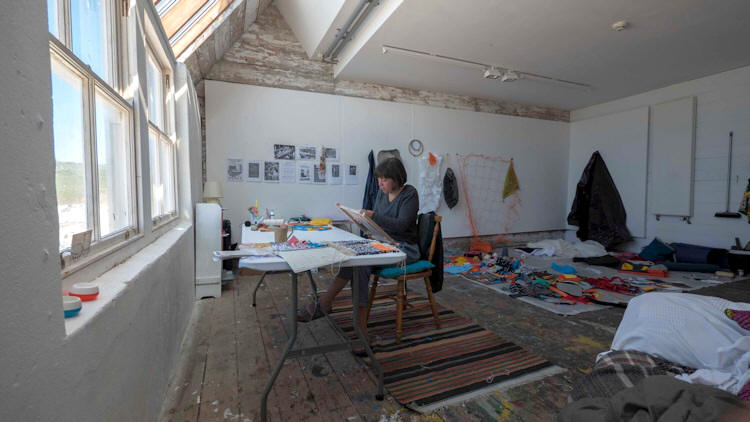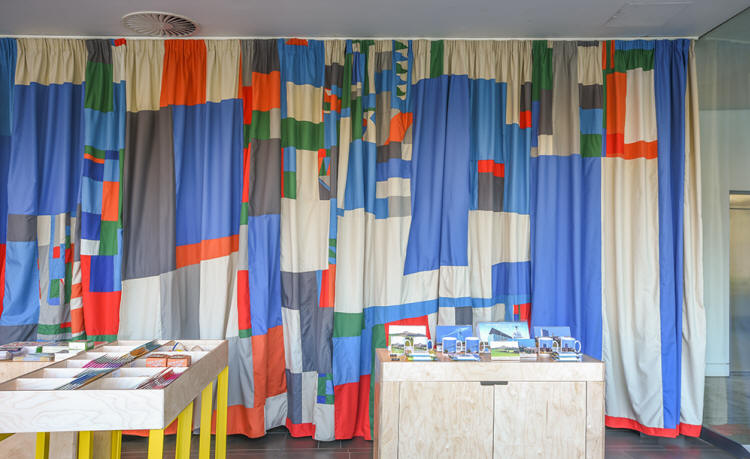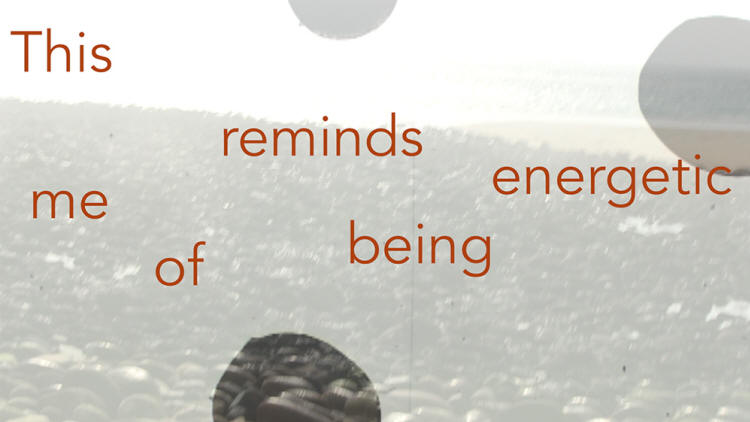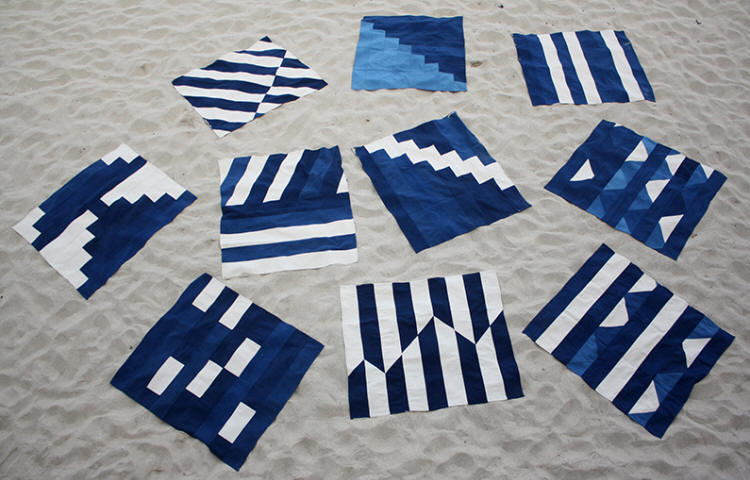|
|
| home | exhibitions | interviews | features | profiles | webprojects | archive |
|
Katie Schwab on the Porthmeor Studios, handcraft and creative labour Interview by curator Laura Smith (formally of Tate St Ives, now Whitechapel Gallery).
With interviews like this I always like to start at the beginning, with how your work begins – could you say a little about this? My work spans exhibition-making, design commissions, printed resources and workshops, and while the outcome of each project varies, the beginnings are often quite similar. I tend to begin with thinking about the context that the work is being made for. For example, with a gallery this might mean considering the collection or archives, the architecture or the landscape, and the local creative, industrial and manufacturing histories. If I am being commissioned to make work for a site it is always important for me to meet and talk with people that work in, use and visit it. I also spend a lot of time in the space and local surroundings, observing, making notes and thinking. This is then generally followed by a period in the studio, collating research, reading and thinking about how a work could begin to respond to, and develop from these experiences. From here, the evolution of the work depends on the project- it might be that the work grows through a number of workshops, conversations or making sessions with people. Or I might put together something in the studio in response to this research. Or it can be a combination of these processes, all of which explore an interest in craft, design and educational histories, and how these connect to forms of living, making and working collectively.
How does your work operate between the realms of ‘fine’ art and design? I know that you are interested in modernist design for example and I wonder how that influence sits alongside – or informs – your practice as an artist? Design is of interest to me because it is intrinsically social and connects directly with daily life and lived experiences. Although I went through a Fine Art education, the majority of my work draws on early to mid- twentieth century design, although it is also open to influences from across art, literature, education, politics and social history. I am interested in modernist design primarily through the woven, embroidered, printed, ceramic and written work of women artists and designers from that period: in particular works by Anni Albers, Gunta Stölzl, Sonia Delaunay, Phyllis Barron, Dorothy Larcher and Marguerite Wildenhain. These works raise questions for me around learning, the home, family, friendships, handcrafts and production, and I am interested in exploring these histories of design, feminism, craft and industry. Within my practice I embrace both the hand-made and the small batch- produced, I use economical materials, I often make works within or for a domestic environment, I am interested in improvisation and repeat patterns and my work draws on a palette of post-war plastics, yarns and paints.
These processes come out of an interest in what it is possible to do with the hand, either at home or in a small-scale studio or workshop. I was introduced to each of these processes through friends and family members or through attending short courses and evening classes: my grandmother was an avid embroiderer, my friend Sarah Johnson makes indigo dyed clothes and I took ceramics evening classes at City and Islington College and a short tapestry course at West Dean College. I am interested in the different ways that craft skills can be passed on, and the intrinsically social aspect of this practice, whether formal or informal. ‘Handcrafted’ works, often historically made by women, have not always been considered in the same realm as art and design. I am interested in exploring these making processes with people that are also curious about, and excited by, these histories and the possibilities of making with the hand. I would say that these processes probably impact the scale of the works that I can make, as they are often dependent on domestic sized production facilities. Being connected to the making process is very important for me, and this often means that work evolves slowly, reliant on a process of building friendship, trust, confidence and skills. There are many other processes that I would love to work with, for example cane weaving, basketry and upholstery, but I think that it takes time to meet the right person, or be in the right space or situation, to explore these techniques together.
To me, ‘collective’ evokes a history of shared activity which is often connected to activism and practices of communal living and working. ‘Manufacture’ indicates a history of production which involves machines, assembly lines and industrial fabrication. I think collective manufacture falls somewhere between these terms, and certainly in my work I am interested in exploring the possible shared, creative space of an informal production line. I understand the term creative labour as being a form of work which doesn’t always have a physical output: spaces where play, discussion and material investigation can foreground emotion, the senses and critical thinking rather than outcomes, productivity and value for money. I think about this with the workshops I facilitate, where I try to create a loose framework or palette that can enable movement, curiosity and exploration within it.
I was 17 when I first started working with Tate Modern’s peer-led youth programme and have subsequently worked across learning departments in different museums and galleries. In a sense, I have grown up alongside these programmes, and have been able to reflect on the ways that museums and galleries can encourage play and material exploration, creative and critical thinking; variously enabling people to feel challenged, encouraged, supported and cared for. These programmes draw on educational models such as the Reggio Emilia approach and forms of de-schooling and unlearning. My interest in these is paralleled with an interest in forms of learning around craft and design. This is where the Bauhaus is relevant, as well as organisations such as Black Mountain College, Dartington and West Dean College. It is also where evening classes and short courses play a role today. These experiences and research interests have been hugely influential for me in thinking about ways that radical pedagogical practices can connect with aspects of craft and design learning. This has been important both within the workshops that I facilitate, but also in the way that works develop… I try to explore ways for making processes to be shared, exploring forms of practice that are reflective, active, supportive, encouraging and open.
Finally, let’s talk about your time in St Ives, could you say something about what attracted you to do the residency at Porthmeor? And what you wanted to get out of it or to happen during the residency? In 2016 I was invited by the Learning Department at Tate St Ives to devise a programme of Easter activities for families at Porthmeor Studios. The resulting project, ‘Zig-Zag, Circle, Pillar’ (above) incorporated a series of activities that drew on a history of artist-designed textiles (in particular works by Patrick Heron, Barbara Hepworth, Henry Moore and Ben Nicholson), and the historic relationship of the studio site to fishing and netting. I worked remotely on the project and was really keen to get a chance to visit the studios in person and develop this research further. I was then kindly nominated for the Porthmeor Artists Residency Programme at Porthmeor Studios by Collective in Edinburgh. The residency was an opportunity for an emerging artist based in Scotland to work from Porthmeor Studios for a period, and was generously supported by the Wilhelmina Barns-Graham Trust (an artist who also spent her time between Scotland and Cornwall). I was delighted to be selected for the residency, to spend time in St Ives getting to know a wonderful group of people, and to make new work in such an inspiring setting. I have always been interested in histories of artist designed textiles and was interested to spend time researching fabric works by Patrick Heron, Barbara Hepworth, Henry Moore and Ben Nicholson. I was also drawn to the historic relationship of the Porthmeor studio site to fishing and netting and planned to spend my time in St Ives learning processes of net-making, and connected forms of crocheting, knotting and knitting.
How was your residency time used? And has it made anything possible that might not have been possible if you had stayed in Scotland? My three months at Porthmeor became five, and I ended up staying in St Ives for over six months and have been back numerous times since! I was very fortunate to be able to stay at Chy an Creet which is a live/ work space for textile designers close to the Leach Pottery. This, along with the connections at Porthmeor and participation in The Cornwall Workshop, enabled me to meet many wonderful artists, designers, makers, potters and curators in the area. While on the residency I worked on A Portable Mural, a printed Architecture Family Pack for the Serpentine Galleries to accompany Francis Kéré’s 2017 Pavilion. The piece incorporated a strip of indigo, dyed with my flatmate Sarah Johnson, and cyanotypes made from a woven tapestry, exposed in the sunlight in the studio courtyard. Sarah and I also dyed and stitched a collection of ten indigo blankets for use in the Pavilion (below). I also worked on woven and patchwork samples for MIMA, undertook a throwing course at the Leach and spent time in the St Ives Archives and Penlee House researching Cryséde (a factory on the St Ives Island which manufactured wood-block printed silk fabrics and garments in the 1920s and 30s). In St Ives I have felt closer to the landscape than in Glasgow, and have been very interested to meet makers who draw on the natural environment both for inspiration and materials.
The residency has been wonderful, both as inspiration for my work and for adjusting my working practices. I have had many interesting conversations with artists, makers and designers around sustainability, natural resources and minimal impact making processes, making me reflect more on the materials and making processes I employ in my practice. I’ve also been thinking a lot about trade routes and connections across the UK- during The Cornwall Workshop we visited the site of the China Clay pit at Tregonning Hill- a material that enabled the production and export of English Porcelain. Cryséde had fabric spun in Yorkshire which was dyed and printed in St Ives and later distributed to shops across the UK. It’s been interesting to think about these national and international movements of materials and products. The research and experiments undertaken at Porthmeor feel like the start of a new body of work. I’m currently undertaking a Design Residency at Plymouth College of Art and I anticipate that the work produced there over the next year will have a strong St Ives connection!
Katie Schwab http://www.katieschwab.com was the first artist selected for the emerging artist strand of the Porthmeor Artists Residency Programme, part of the Borlase Smart John Wells Trust http://www.bsjwtrust.co.uk. Katie Schwab's residency was supported by, the Wilhelmina Barn-Graham Trust April to June 2017.
Photos courtesy Alban Roinard. |
|
|




